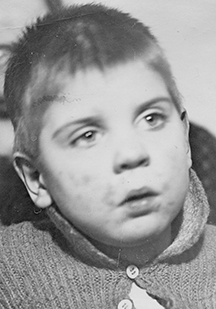Search for Names, Places and Biographies
Already layed Stumbling Stones
Suche
Jutta Berndt * 1932
Ritterstraße 47/49 (Wandsbek, Eilbek)
HIER WOHNTE
JUTTA BERNDT
JG. 1932
EINGEWIESEN 17.7.1935
ALSTERDORFER ANSTALTEN
‚VERLEGT’ 16.8.1943
HEILANSTALT
AM STEINHOF WIEN
ERMORDET 16.12.1944
Jutta Berndt, born on 27 July 1932 in Hamburg, murdered on 16 Dec. 1944 at the Vienna Municipal Wagner von Jauregg-Heil- und Pflegeanstalt
Ritterstraße 47/49
Jutta Berndt was born the second child of Carl and Sophia Berndt at Barmbek General Hospital. The commercial clerk Carl Cäsar Berndt, born on 23 Apr. 1906, was from Seppensen-Mühle, Harburg District, and Sophia, née Ullrich, from Dörnigheim, Hanau District. They were married on 25 Oct. 1928 in Hamburg.
What initially looked like a normal delivery turned out to be a difficult birth. During the birth, Jutta suffered from a brain hemorrhage, which was regarded as the cause of her subsequent illness.
Her sister, on the other hand, delivered by forceps, developed without any disorders. Soon after her birth, Jutta was placed in the children’s home on Höltystraße but sent home in the winter of 1932/33 because the cost allowance of the statutory health insurance plan ran out. After coverage of costs was settled, she was admitted there again and relocated on 17 July 1935 to what used to be the Alsterdorf Asylum (Alsterdorfer Anstalten) at the time. Jutta could neither speak nor walk, though she was able to move independently in her walking chair. Spastic seizures and malalignment of her feet prevented her from walking. She reacted joyfully to affection and contact. In the years from 1935 to 1937, she suffered from many illnesses with the effect that she could not attend infant school and could not go home on holidays. On 18 Jan. 1938, with Jutta five and a half years old, the report from infant school read: "She continues to make progress, repeating simple words with much effort. She is capable of crafting a necklace using coarse-grained pearls, occupies herself enduringly with toy bricks and wooden animals, also makes simple attempts at sewing in [sewing or embroidering pre-sketched patterns], and likes to follow pictures being shown. She is very affectionate and takes pleasure in helping, always participating eagerly.”
Jutta made further progress with her independence. She dressed herself on her own, climbed out of bed, pulled herself along on beds and chairs, and crawled to where she wanted to go. In 1940, one of her Achilles’ tendons was severed in the hope that she would then be able to stand on her foot; the procedure was unsuccessful. Jutta moved with the help of a small cart and was able to go to the bathroom by herself.
By contrast, the expert’s report prepared on her tenth birthday in 1942 to justify her continued need for being institutionalized read as follows: "The patient suffers from Little’s Disease and feeble-mindedness. She is very nervous, obstinate, and badly behaved, tears up her things and wets her bed. At night, she has to be in a protective jacket, during the day secured by a strap. Her speech is difficult to comprehend.” She was granted the need for being institutionalized and thus coverage of costs by the welfare administration until 30 Sept. 1946.
On 16 Aug. 1943, Jutta Berndt was relocated together with 227 other girls and women to the Vienna Municipal Wagner von Jauregg-Heil- und Pflegeanstalt, a sanatorium and nursing home. Her parents, bombed out during the massive air raids on Hamburg in July 1943, found accommodation on Eidelstedter Weg, maintaining frequent correspondence with the Viennese institute. In Vienna, Jutta settled in soon and took an active interest in her environment. In contrast to Alsterdorf, due to her inability to walk, nursing staff kept her confined in bed, where she had to be cared for completely. The Reich Governor (Reichsstatthalter) of Vienna, Baldur von Schirach, commissioned an examination of Jutta Berndt concerning her educability, which Senior Medical Officer Ernst Illing carried out on 21 Sept. 1944. The result turned out negatively. The mother learned nothing about this. A letter by the institution dated 12 Oct. 1944, on the other hand, stated: "Your daughter, Jutta Berndt, is mentally and physically well, only suffering from colds constantly, since she does not want to stay in bed and crawls around the floor all the time.” On 9 Dec. 1944, a detailed expert’s report was prepared regarding Jutta’s physical condition, particularly her muscles that produce speech, which had reduced mobility, and her inability to walk. The report was followed, five days later already, by the transfer to a different station, where she died on 16 Dec., supposedly of pneumonia. The course of the last days of her life suggests that she was murdered in the "Spiegelgrund,” the institute’s "children’s special ward.”
On 8 Jan. 1945, her father Carl Berndt received the notification that she had died of purulent tracheitis and pneumonia. He was not satisfied with this, demanding a detailed report on her fatal illness.
Whether he ever received it cannot be ascertained. Jutta Berndt reached the age of 12.
Status as of Feb. 2014
Translator: Erwin Fink
Kindly supported by the Hermann Reemtsma Stiftung, Hamburg.
© Hildegard Thevs
Quellen: Ev. Stiftung Alsterdorf, Archiv, V 381; StaH 332-5 Standesämter 3586-905/1928; Jenner, Meldebögen, in: Wunder/Genkel/Jenner, Auf dieser schiefen Ebene; Wunder, Abtransporte, in: Wunder/Genkel/ Jenner, Auf dieser schiefen Ebene; ders., Exodus, ebd.


